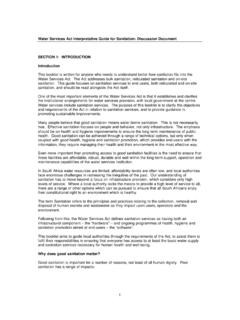Transcription of Water, Sanitation and Hygiene Standards for …
1 water , Sanitation and Hygiene Standards for Schools in Low-cost Settings Edited by: John Adams, Jamie Bartram, Yves Chartier, Jackie Sims WHO Library Cataloguing-in-Publication Data world health organization . water , Sanitation and Hygiene Standards for schools in low-cost settings Edited by John Adams, Jamie Bartram, Yves Chartier, Jackie Sims supply Standards . quality. Standards . Standards . health services organization and administration. vectors. policy. countries. , John. health organization .
2 ISBN 978 92 4 154779 6 (NLM classification: WA 675) world health organization 2009 All rights reserved. Publications of the world health organization can be obtained from WHO Press, world health organization , 20 Avenue Appia, 1211 Geneva 27, Switzerland (tel.: +41 22 791 3264; fax: +41 22 791 4857; e-mail: Requests for permission to reproduce or translate WHO publications whether for sale or for noncommercial distribution should be addressed to WHO Press, at the above address (fax: +41 22 791 4806; e-mail: The designations employed and the presentation of the material in this publication do not imply the expression of any opinion whatsoever on the part of the world health organization concerning the legal status of any country, territory, city or area or of its authorities, or concerning the delimitation of its frontiers or boundaries.))
3 Dotted lines on maps represent approximate border lines for which there may not yet be full agreement. The mention of specific companies or of certain manufacturers products does not imply that they are endorsed or recommended by the world health organization in preference to others of a similar nature that are not mentioned. Errors and omissions excepted, the names of proprietary products are distinguished by initial capital letters. All reasonable precautions have been taken by the world health organization to verify the information contained in this publication.
4 However, the published material is being distributed without warranty of any kind, either expressed or implied. The responsibility for the interpretation and use of the material lies with the reader. In no event shall the world health organization be liable for damages arising from its use. The named editors alone are responsible for the views expressed in this publication. Designed by Design ONE, Canberra, Australia The cover photographs are: a boy in Nepal (Black, WHO), two girls washing hands in Rwanda (Pirozzi, UNICEF), a girl demonstrating hand washing in a school in Nigeria (Nesbitt, UNICEF), two girls going to a block of toilets in Rwanda (Pirozzi, UNICEF), a child pouring water in a toilet in Egypt (Pirozzi, UNICEF) and a school teacher helping a child with hand washing in Jamaica (Markisz, UNICEF).
5 Iii Summary Diseases related to inadequate water , Sanitation and Hygiene are a huge burden in developing countries. It is estimated that 88% of diarrhoeal disease is caused by unsafe water supply, and inadequate Sanitation and Hygiene (WHO, 2004c). Many schools serve communities that have a high prevalence of diseases related to inadequate water supply, Sanitation and Hygiene , and where child malnutrition and other underlying health problems are common. Schools, particularly those in rural areas, often completely lack drinking- water and Sanitation and handwashing facilities; alternatively, where such facilities do exist they are often inadequate in both quality and quantity.
6 Schools with poor water , Sanitation and Hygiene conditions, and intense levels of person-to-person contact, are high-risk environments for children and staff, and exacerbate children s particular susceptibility to environmental health hazards. Children s ability to learn may be affected by inadequate water , Sanitation and Hygiene conditions in several ways. These include helminth infections (which affect hundreds of millions of school-age children), long-term exposure to chemical contaminants in water ( lead and arsenic), diarrhoeal diseases and malaria infections, all of which force many schoolchildren to be absent from school.
7 Poor environmental conditions in the classroom can also make both teaching and learning very difficult. Girls and boys are likely to be affected in different ways by inadequate water , Sanitation and Hygiene conditions in schools, and this may contribute to unequal learning opportunities. Sometimes, girls and female teachers are more affected than boys because the lack of sanitary facilities means that they cannot attend school during menstruation. The international policy environment increasingly reflects these issues.
8 Providing adequate levels of water supply, Sanitation and Hygiene in schools is of direct relevance to the United Nations (UN) Millennium Development Goals of achieving universal primary education, promoting gender equality and reducing child mortality. It is also supportive of other goals, especially those on major diseases and infant mortality. At the same time, the UN Millennium Project and the UN Secretary-General have highlighted the importance of rapidly addressing quick wins ; that is, identifying specifically provision of services to schools and health -care facilities.
9 Guidelines on water , Sanitation and Hygiene in schools are widely available, but additional guidance and Standards for low-cost settings are needed. The development and implementation of national policies, guidelines for safe practices, training and promotion of effective messages in a context of healthy schools will decrease the toll taken by inadequate water , Sanitation and Hygiene . iv These guidelines deal specifically with water , Sanitation and Hygiene , and are designed to be used in schools in low-cost settings in low- and medium-resource countries to: assess prevailing situations and plan for required improvements; develop and reach essential safety Standards as a first goal; and support the development and application of national policies.
10 The guidelines are written for use by education managers and planners, architects, urban planners, water and Sanitation technicians, teaching staff, school boards, village education committees, local authorities and similar bodies. v Contents Acknowledgements ..vii Acronyms and 1 Purpose and scope of these guidelines ..1 Policy rationale ..1 School Relation to national Standards and 2 Importance of adequate water supply, Sanitation and Hygiene in schools ..5 Disease Gender and The wider Life-long 3 Implementation.
















